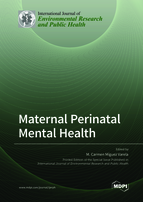Maternal Perinatal Mental Health
A special issue of International Journal of Environmental Research and Public Health (ISSN 1660-4601). This special issue belongs to the section "Women's Health".
Deadline for manuscript submissions: closed (30 June 2021) | Viewed by 50692
Special Issue Editor
Interests: perinatal mental health; smoking and pregnancy; perinatal anxiety and depression; smoking
Special Issues, Collections and Topics in MDPI journals
Special Issue Information
Dear Colleagues,
This Special Issue will focus on women's mental health at two important periods in their lives: pregnancy and postpartum. Therefore, we are seeking high-quality contributions on themes relating to perinatal mental health. Research on the topic includes prevalence, screening and diagnostic instruments, comorbidity, associated and/or risk factors, effects or consequences, and interventions.
An estimated one in five women will develop a mental disorder during pregnancy and/or postpartum up to one year after childbirth. Depression and anxiety are the most prevalent perinatal mental disorders and a major public health problem with adverse health consequences for mother and baby. Despite this, there is no standard protocol that healthcare professionals can follow to help them detect possible cases of mental health problems. As a result, many women are left unscreened, undiagnosed, and thus untreated for a treatable disorder. On the other hand, to design specific prevention and intervention programs, it is crucial to investigate the variables associated with an increased risk of perinatal mental-health problems. For example, substance abuse (tobacco and alcohol) is often associated with mental-health disorders.
This Special Issue will interest researchers and practitioners in mental health, maternal and child health, women´s health, obstetrics/gynecology, and pediatrics. I hope that this Special Issue will also encourage healthcare professionals to be more aware of the importance of this issue, screen for prenatal and postpartum depression or anxiety, and learn about mental-health resources available in their communities.
I invite those of you working in this area to submit articles on themes relating to mental health in pregnancy and postpartum. The keywords listed below provide an outline of some areas of potential interest.
Prof. Dr. María Carmen Míguez Varela
Guest Editor
Manuscript Submission Information
Manuscripts should be submitted online at www.mdpi.com by registering and logging in to this website. Once you are registered, click here to go to the submission form. Manuscripts can be submitted until the deadline. All submissions that pass pre-check are peer-reviewed. Accepted papers will be published continuously in the journal (as soon as accepted) and will be listed together on the special issue website. Research articles, review articles as well as short communications are invited. For planned papers, a title and short abstract (about 100 words) can be sent to the Editorial Office for announcement on this website.
Submitted manuscripts should not have been published previously, nor be under consideration for publication elsewhere (except conference proceedings papers). All manuscripts are thoroughly refereed through a single-blind peer-review process. A guide for authors and other relevant information for submission of manuscripts is available on the Instructions for Authors page. International Journal of Environmental Research and Public Health is an international peer-reviewed open access monthly journal published by MDPI.
Please visit the Instructions for Authors page before submitting a manuscript. The Article Processing Charge (APC) for publication in this open access journal is 2500 CHF (Swiss Francs). Submitted papers should be well formatted and use good English. Authors may use MDPI's English editing service prior to publication or during author revisions.
Keywords
- Perinatal mental health
- Perinatal depression
- Perinatal anxiety
- Assessment tools
- Epidemiology
- Perinatal mental health and tobacco consumption
- Perinatal mental health and alcohol consumption
- Risk factors
- Effects
- Prevention
- Treatment






